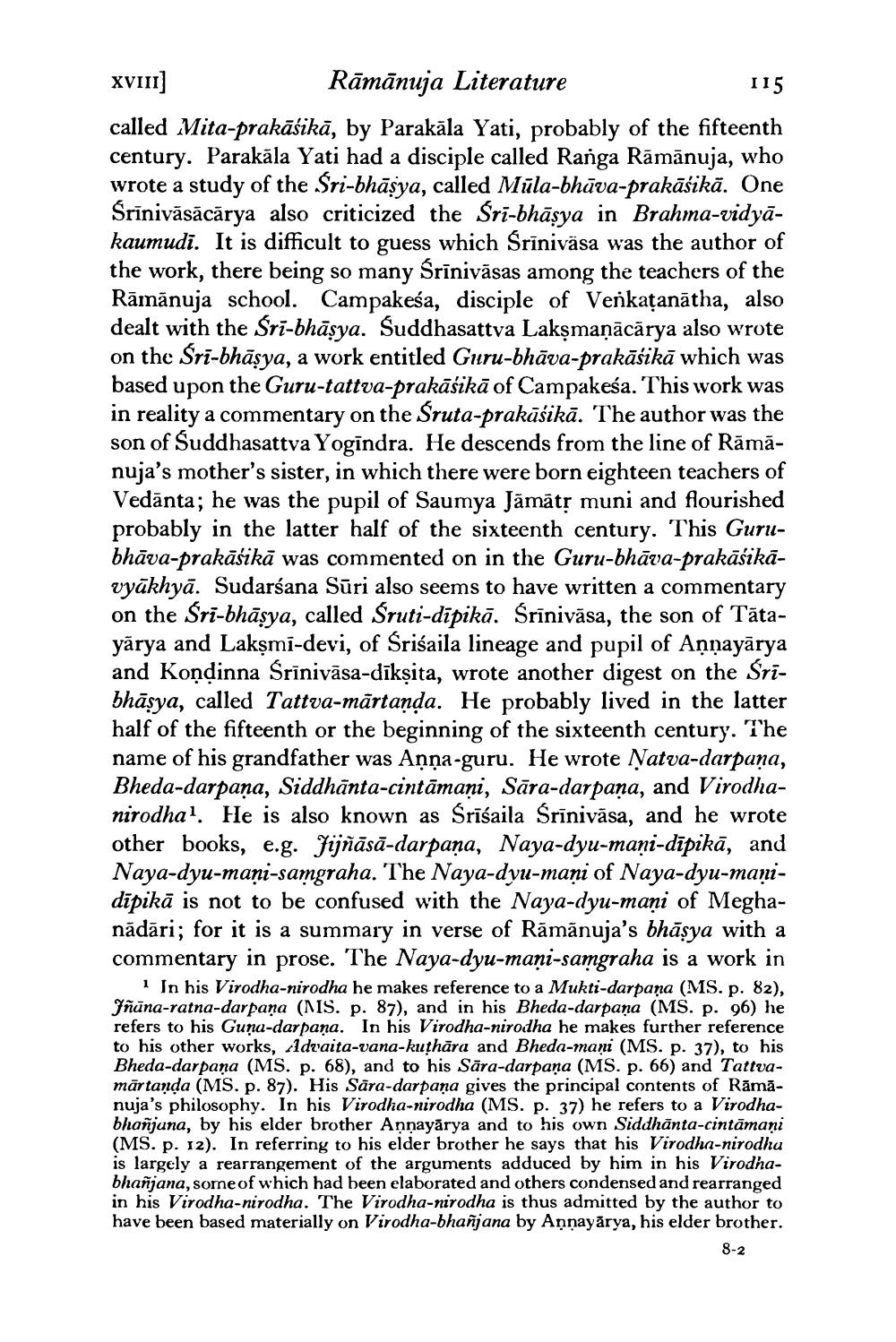________________
XVIII]
Rāmānuja Literature
115
called Mita-prakāśikā, by Parakāla Yati, probably of the fifteenth century. Parakala Yati had a disciple called Ranga Rāmānuja, who wrote a study of the Sri-bhāṣya, called Mūla-bhāva-prakāśikā. One Śrīnivāsācārya also criticized the Śrī-bhāṣya in Brahma-vidyakaumudi. It is difficult to guess which Śrīniväsa was the author of the work, there being so many Śrīnivāsas among the teachers of the Rāmānuja school. Campakeśa, disciple of Venkaṭanātha, also dealt with the Śrī-bhāṣya. Suddhasattva Lakṣmaṇācārya also wrote on the Śrī-bhāṣya, a work entitled Guru-bhāva-prakāśikā which was based upon the Guru-tattva-prakāśikā of Campakeśa. This work was in reality a commentary on the Śruta-prakāśikā. The author was the son of Suddhasattva Yogindra. He descends from the line of Rāmānuja's mother's sister, in which there were born eighteen teachers of Vedanta; he was the pupil of Saumya Jāmātṛ muni and flourished probably in the latter half of the sixteenth century. This Gurubhāva-prakāśikā was commented on in the Guru-bhāva-prakāśikāvyākhyā. Sudarśana Sūri also seems to have written a commentary on the Śrī-bhāṣya, called Śruti-dīpikā. Śrīnivāsa, the son of Tatayārya and Lakṣmi-devi, of Śriśaila lineage and pupil of Anṇayārya and Kondinna Śrīnivāsa-dīkṣita, wrote another digest on the Śrībhāṣya, called Tattva-mārtaṇḍa. He probably lived in the latter half of the fifteenth or the beginning of the sixteenth century. The name of his grandfather was Anna-guru. He wrote Natva-darpana, Bheda-darpana, Siddhānta-cintāmaņi, Sāra-darpaṇa, and Virodhanirodha1. He is also known as Śrīśaila Śrīnivāsa, and he wrote other books, e.g. Jijñāsā-darpaṇa, Naya-dyu-maņi-dīpikā, and Naya-dyu-mani-samgraha. The Naya-dyu-mani of Naya-dyu-manidipikā is not to be confused with the Naya-dyu-mani of Meghanādāri; for it is a summary in verse of Rāmānuja's bhāṣya with a commentary in prose. The Naya-dyu-mani-samgraha is a work in
1 In his Virodha-nirodha he makes reference to a Mukti-darpana (MS. p. 82), Jñana-ratna-darpana (MS. p. 87), and in his Bheda-darpana (MS. p. 96) he refers to his Guna-darpana. In his Virodha-nirodha he makes further reference to his other works, Advaita-vana-kuṭhāra and Bheda-mani (MS. p. 37), to his Bheda-darpana (MS. p. 68), and to his Sara-darpana (MS. p. 66) and Tattvamärtaṇḍa (MS. p. 87). His Sara-darpaṇa gives the principal contents of Rāmānuja's philosophy. In his Virodha-nirodha (MS. p. 37) he refers to a Virodhabhanjana, by his elder brother Aṇṇayārya and to his own Siddhānta-cintāmaṇi (MS. p. 12). In referring to his elder brother he says that his Virodha-nirodha is largely a rearrangement of the arguments adduced by him in his Virodhabhanjana, some of which had been elaborated and others condensed and rearranged in his Virodha-nirodha. The Virodha-nirodha is thus admitted by the author to have been based materially on Virodha-bhanjana by Annayarya, his elder brother.
8-2




